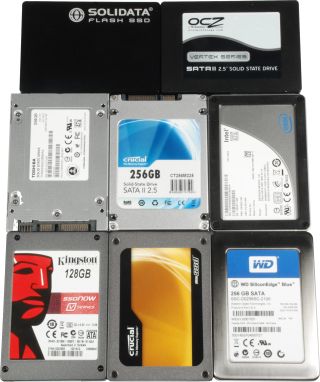Spring 2010 Solid State Drive Roundup, Part 2
In part one of our SSD roundup, we looked at drives from Crucial, OCZ, Intel, Solidata, and Toshiba. To those results, we're adding Crucial's first 6 Gb/s SSD, WD's first SSD, and Kingston's 128GB SSDNow V-series, along with 'fresh' and 'used' scores.
Conclusion
New SSDs from Crucial, Kingston, and Western Digital haven’t made buying decisions any easier. In fact, buying the right drive just got more complex. One thing is clear, though: never, ever buy an SSD product without looking at detailed test results. I encourage everyone to read multiple reviews, given that performance degradation and TRIM, in combination with various possible controllers, operating systems, and testing methodologies has made these waters extremely hard to navigate.
For example, Crucial’s RealSSD C300 and the Intel X25-M G2 provide the highest I/O performance—a key point if you run several virtualized system partitions. On a different front, Toshiba’s HG2 drive is extremely low on power, which might matter more for your laptop than the drive's poor I/O performance. The Indilinx drives are well-balanced, and the two newcomers from Kingston and Western Digital aim at the mainstream and upgrade markets where performance differences might be less important.

In the end, there are a few conclusions worth noting:
- SATA 6Gb/s drives like the RealSSD C300 have the potential to bring SSDs to a whole new level. The throughput is there, but Crucial's performance is too inconsistent at this point. We're waiting for an update from the company on a fix still.
- Drives based on the Indilinx Barefoot controller don’t dominate anywhere in our benchmark suite, but their performance is very reliable.
- Intel remains an excellent choice with the X25-M, both in terms of power consumption and overall performance, with write throughput being the only exception.
- Toshiba and Intel are the best choices if power consumption is your most important consideration.
- Offerings like the Kingston SSDNow V-series and new WD SiliconEdge Blue aren’t low on power and they aren’t the strongest on performance. However, they still outperform hard drives by a significant margin, and they may indeed become interesting options for mainstream users once prices come down.
- Most drives remain too expensive.
- New products aren’t necessarily better than existing drives; Intel's X25-M remains a fierce competitor.
Stay on the Cutting Edge
Join the experts who read Tom's Hardware for the inside track on enthusiast PC tech news — and have for over 25 years. We'll send breaking news and in-depth reviews of CPUs, GPUs, AI, maker hardware and more straight to your inbox.
Most Popular

